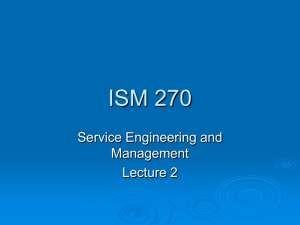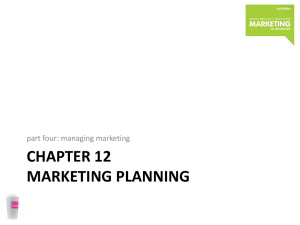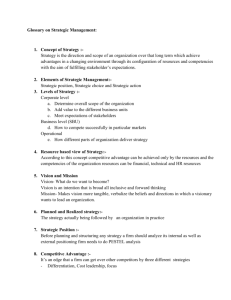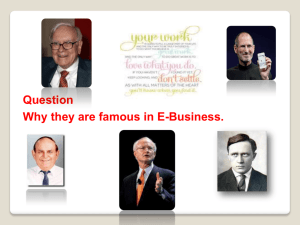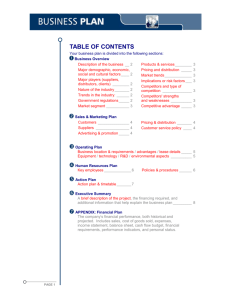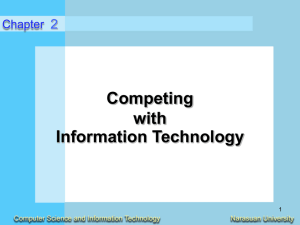Strategy for new service development
advertisement
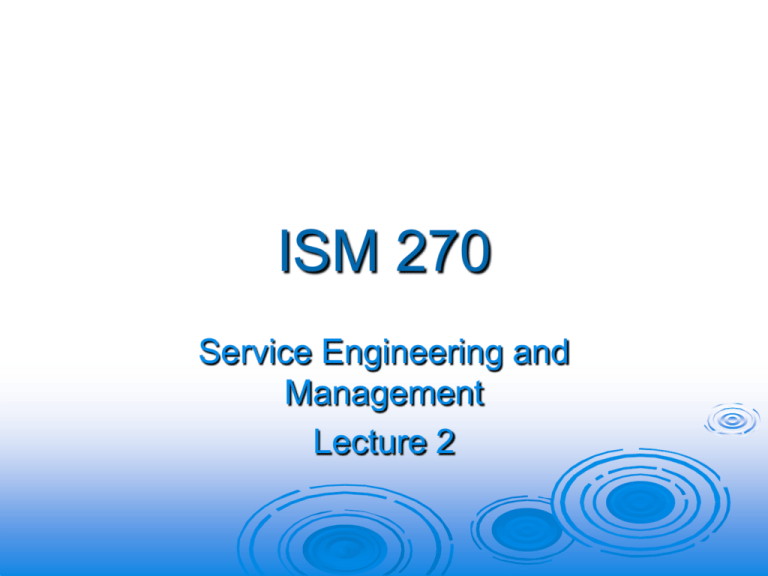
ISM 270 Service Engineering and Management Lecture 2 Paul Maglio Senior Manager, IBM Almaden Research Human Systems and Service Science Research Ph.D. UCSD in Cognitive Science B.S. MIT in Computer Science and Engineering Author of several book chapters, articles, organizer of international conferences on Service Science Management and Engineering (SSME) Notes Class Survey Homework 1 online – due Jan 27 Homework 1: Due in two weeks Three sections: • Statistics Review • Spreadsheet programming • Data Envelopment Analysis Warning: This homework is fairly long, and designed to remind you of things you may not have used for several years! Statistics Review Probability and Random Events Distribution Central Functions Limit Theorem Probability In a random event problem where all events are equally likely P [condition A] = # Events satisfying A / # possible events Density functions PDF = probability density function = probability of random variable equal to each value CDF = cumulative distribution function = probability of random variable being less than or equal to each value = integral of PDF up to that value Conditional Probability P [Event1|Event2] = Prob[Both Events]/Prob[Event2] Conditional PDF f(x|y) = f(x,y) / f(y) Data Envelopment Analysis (DEA) Method for evaluating efficiency of similar venues/products Incorporates inputs and outputs – not just one dimensional Uses LINEAR PROGRAMMING (LP) KEY IDEA: Weight the inputs and outputs to make one unit as efficient as possible, relative to all others If this is 100% efficient, then the unit is on the frontier of efficiency; If less than 100%, there are other units that could utilize the SAME inputs for MORE outputs DEA Example from Text: Burger Palace Small, artificial example for illustration! Page 206 of 7th edition, page 68 of 5th edition, text Burger chain has six units in several cities Each unit uses different combination of labor hours and dollars to produce meals Which units use their resources most efficiently? Productivity of Burger Palace Service Units Service Unit 1 Meals Sold Labor Hours 100 2 Dollars 2 100 4 150 3 100 4 100 4 100 6 100 5 100 8 80 6 100 10 50 200 DEA summary of terms Define variables E_k = efficiency of unit k u_j= coefficient for output j (relative decrease in efficiency per unit reduction of output value) v_i = coefficient for input i (relative increase in efficiency per unit decrease of input value) O_jk = observed ouput j units generated by service unit k during one time period I_ik = no. units input used by service unit k during one period Note: k=1..K = service unit counter j=1..M = output counter i=1..N = input counter DEA Objective and constraints u1O1e u2O2 e ... u M OMe max Ee v1 I1e v2 I 2 e ... v N I Ne s.t. u1O1k u2O2 k ... u M OMk 1, k 1,..., K v1 I1k v2 I 2 k ... v N I Nk u j 0, j 1,2,..., M vi 0, i 1,2,..., N Evaluating unit e Trick = Rescaling to get linear equations v1I1e v 2 I2e ... v N INe 1 s.t. u1O1k u2O2k ... uM OMk (v1I1k v 2 I2k ... v N INk ) 0,k 1,...,K Theory of Strategic Advantage Understanding the Competitive Environment of a Company Companies do not exist in a vacuum: It is necessary to understand the competitive environment to assess the current competitive position of a company. It has become increasingly necessary to posture a company for challenges in its future. Porter Competitive Model Potential New Entrants Bargaining Power of Suppliers Intra-Industry Rivalry Strategic Business Unit Substitute Products and Services Bargaining Power of Buyers Competitive Model Focus • What is driving competition in the current or future industry? • What are current or future competitors likely to do and how can a company respond? • How can a company best posture itself to achieve and sustain a competitive advantage? Competitive Model Forces Intra-industry Rivals: Strategic Business Unit (SBU) and major rivals. Buyers: Categories of major customers. Suppliers: Categories of major suppliers that play a significant role in enabling the SBU to conduct its business. New Entrants: Companies that are new as competitors in a geographic market or existing companies that through a major shift in business strategy will now directly compete with the SBU. Substitutes: An alternative to doing business with the SBU. Porter Competitive Model Education Industry – Universities U.S. Market Potential New Entrants Bargaining Power of Suppliers • Faculty • Staff • Equipment and Service Suppliers • Alumni • Foundations • Governments • IT Vendors • Foreign Universities • Shift in Strategy by Universities or Companies Intra-Industry Rivalry SBU: UCSC Rivals: UC campuses, CSU, Private universities, Community Colleges Substitute Products and Services • Internet Distance Learning • Books and Videotapes • Computer-Based Training • Company Education Programs Bargaining Power of Buyers • Students • Parents • Businesses • Employers • Legislators Role of Technology through Porter perspective: Can we… 1. Build barriers to prevent a company from entering an industry? 2. Build in costs that would make it difficult for a customer to switch to another supplier? 3. Change the basis for competition within the industry? 4. Change the balance of power in the relationship that a company has with customers or suppliers? 5. Provide the basis for new products and services, new markets or other new business opportunities Porter Competitive Strategies Cost Leadership Strategies Differentiation Strategies Primary Strategies Innovation Strategies Supporting Strategies Growth Strategies Alliance Strategies Porter Primary Strategies Differentiation—customer values the differences that you provide in products, services or capabilities. Cost—is least cost. If this is the primary strategy, over time there will only one ultimate winner. Porter Supporting Strategies Innovation—either with business strategies or use of information systems or both. Growth—deals with growth in revenue and other business volumes. Can be a key factor in establishing a market position. Can also be a major requirement to offset high fixed operating costs. Alliances—importance of establishing a strong relationship with suppliers and other business partners often on a contractual basis. Dell, Inc. Strategies Primary Strategy: Differentiation Least Cost Supporting Strategies: Innovation Growth Alliances IT Significance Information Technology can change the way that an organization (business or public sector) competes. • As the foundation for organizational renewal. • As a necessary investment that should help achieve and sustain strategic objectives. • As an increasingly important communication network among employees and with customers, suppliers, business partners and even competitors. Strategic Roles of Information Systems Specific Examples: Lower Costs Differentiate Innovate Promote Growth Develop Alliances Improve Quality and Efficiency Build an IT Platform Support (enable) other Strategies Characterizing Services An Integrated Approach to Service Management The Eight Components • Product Elements • Place, Cyberspace, and Time • Promotion and Education • Price and Other User Outlays + Process + Productivity and Quality + People + Physical Evidence Require the Integration of Marketing, Operations, and Human Resources Goods or Services? Service/Product Bundle Element Business Core Goods Example Custom clothier Core Service Example Business hotel Core Business suits Peripheral Goods Garment bag Room for the night Bath robe Peripheral Service Variant Deferred payment plans In house restaurant Coffee lounge Airport shuttle The Service Process Matrix Degree of labor Intensity Degree of Interaction and Customization Low High Low Service factory: * Airlines * Trucking * Hotels * Resorts and recreation High Service shop: * Hospitals * Auto repair * Other repair services Mass service: * Retailing * Wholesaling * Schools * Retail aspects of commercial banking Professional service: * Doctors * Lawyers * Accountants * Architects The Service Package Supporting Facility: The physical resources that must be in place before a service can be sold. Examples are golf course, ski lift, hospital, airplane. Facilitating Goods: The material consumed by the buyer or items provided by the consumer. Examples are food items, legal documents, golf clubs, medical history. Information: Operations data or information that is provided by the customer to enable efficient and customized service. Examples are patient medical records, seats available on a flight, customer preferences, location of customer to dispatch a taxi. Explicit Services: Benefits readily observable by the senses. The essential or intrinsic features. Examples are quality of meal, attitude of the waiter, on-time departure. Implicit Services: Psychological benefits or extrinsic features which the consumer may sense only vaguely. Examples are privacy of loan office, security of a well lighted parking lot. Distinctive Characteristics of Services Customer Participation in the Service Process: attention to facility design but opportunities for co-production Simultaneity: opportunities for personal selling, interaction creates customer perceptions of quality Perishability: cannot inventory, opportunity loss of idle capacity, need to match supply with demand Intangibility: creative advertising, no patent protection, importance of reputation Heterogeneity: customer participation in delivery process results in variability Strategic Service Classification (Nature of the Service Act) Direct Recipient of the Service Nature of the Service Act People People’s bodies: Tangible actions Health care Passenger transportation Beauty salons Exercise clinics Restaurants People’s minds: Intangible actions Education Broadcasting Information services Theaters Museums Things Physical possessions: Freight transportation Repair and maintenance Veterinary care Janitorial services Laundry and dry cleaning Intangible assets: Banking Legal services Accounting Securities Insurance Strategic Service Classification (Relationship with Customers) Type of Relationship between Service Organization and Its Customers Nature of Service Delivery “Membership” relationship Continuous delivery of service Discrete transactions Insurance Telephone subscription Electric Utility Banking Long-distance phone calls Theater series tickets Transit pass Sam’s Wholesale Club Airline frequent flyer No formal relationship Radio station Police protection Lighthouse Public Highway Restaurant Pay phone Toll highway Movie theater Public transportation Strategic Service Classification (Customization and Judgment) Extent to Which Service Characteristics Are Customized Extent to Which Personnel Exercise Judgment in Meeting Customer Needs High Low High Low Surgery Taxi services Gourmet restaurant Preventive health programs Education (large classes) Family restaurant Telephone service Hotel services Retail banking Cafeteria Public transportation Spectator sports Movie theater Institutional food service Strategic Service Classification (Nature of Demand and Supply) Extent of Demand Fluctuation over Time Extent to which Supply Is Constrained Peak demand can usually be met without a major delay Peak demand regularly exceeds capacity Wide Narrow Electricity Insurance Telephone Legal services Police emergency Banking Hospital maternity unit Laundry and dry cleaning Tax preparation Fast food restaurant Passenger transportation Movie theater Hotels and motels Gas station Strategic Service Classification (Method of Service Delivery) Availability of Service Outlets Nature of Interaction between Customer and Service Organization Single site Multiple site Customer travels to Theater service organization Service provider travels to customer Transaction is at arm’s length Bus service Barbershop Taxi Pest control service Credit card company Local TV station Fast-food chain Mail delivery AAA emergency repairs Broadcast network Telephone company Open Systems View of Services Service Process Consumer arrivals (input) Consumer participant Consumer-Provider interface Control Customer demand Perceived needs Location Consumer Evaluation departures ( output) Criteria Measurement Monitor Service operations manager Production function: Alter Monitor and control process Schedule demand Marketing function: supply Interact with consumers Control demand Modify as necessary Define standard Communicate by advertising Service package Supporting facility Facilitating goods Explicit services Implicit services Basis of selection Service personnel Empowerment Training Attitudes Service Strategy Strategic Service Vision Target Market Segments What are common characteristics of important market segments? What dimensions can be used to segment the market, demographic, psychographic? How important are various segments? What needs does each have? How well are these needs being served, in what manner, by whom? Strategic Service Vision Service Concept What are important elements of the service to be provided, stated in terms of results produced for customers? How are these elements supposed to be perceived by the target market segment, by the market in general, by employees, by others? How do customers perceive the service concept? What efforts does this suggest in terms of the manner in which the service is designed, delivered, marketed? Strategic Service Vision Operating Strategy What are important elements of the strategy: operations, financing, marketing, organization, human resources, control? On which will the most effort be concentrated? Where will investments be made? How will quality and cost be controlled: measures, incentives, rewards? What results will be expected versus competition in terms of, quality of service, cost profile, productivity, morale/loyalty of servers? Strategic Service Vision Service Delivery System What are important features of the service delivery system including: role of people, technology, equipment, layout, procedures? What capacity does it provide, normally, at peak levels? To what extent does it, help insure quality standards, differentiate the service from competition, provide barriers to entry by competitors? Competitive Environment of Services Relatively Low Overall Entry Barriers Economies of Scale Limited High Transportation Costs Erratic Sales Fluctuations No Power Dealing with Buyers or Suppliers Product Substitutions for Service High Customer Loyalty Exit Barriers Competitive Service Strategies (Overall Cost Leadership) Seeking Out Low-cost Customers Standardizing a Custom Service Reducing the Personal Element in Service Delivery (promote self-service) Reducing Network Costs (hub and spoke) Taking Service Operations Off-line Competitive Service Strategies (Differentiation) Making the Intangible Tangible (memorable) Customizing the Standard Product Reducing Perceived Risk Giving Attention to Personnel Training Controlling Quality Note: Differentiation in service means being unique in brand image, technology use, features, or reputation for customer service. Competitive Service Strategies (Focus) Buyer Group: (e.g. USAA insurance and military officers) Service Offered: (e.g. Shouldice Hospital and hernia patients) Geographic Region: (e.g. Austin Cable Vision and TV watchers) Customer Criteria for Selecting a Service Provider Availability Convenience Dependability Personalization Price Quality Reputation Safety Speed (24 hour ATM) (Site location) (On-time performance) (Know customer’s name) (Quality surrogate) (Perceptions important) (Word-of-mouth) (Customer well-being) (Avoid excessive waiting) Service Purchase Decision Service Qualifier: To be taken seriously a certain level must be attained on the competitive dimension, as defined by other market players. Examples are cleanliness for a fast food restaurant or safe aircraft for an airline. Service Winner: The competitive dimension used to make the final choice among competitors. Example is price. Service Loser: Failure to deliver at or above the expected level for a competitive dimension. Examples are failure to repair auto (dependability), rude treatment (personalization) or late delivery of package (speed). Competitive Role of Information in Services Strategic Focus External (Customer) Internal (Operations) Competitive Use of Information On-line (Real time) Off-line (Analysis) Creation of barriers to entry: Data base asset: Reservation system Frequent user club Switching costs Selling information Development of services Micro-marketing Revenue generation: Productivity enhancement Yield management Point of sale Expert systems Inventory status Data envelopment analysis (DEA) The Virtual Value Chain Marketplace vs Marketspace Creating New Markets Using Information (Gather, Organize, Select, Synthesize, and Distribute) Three Stage Evolution • 1st Stage (Visibility): See physical operations more effectively with information – Ex. USAA “paperless operation” • 2nd Stage (Mirroring Capability): Substitute virtual activities for physical – Ex. USAA “automate underwriting” • 3rd Stage (New Customer Relationships): Draw on information to deliver value to customer in new ways – Ex. USAA “event oriented service” Limits in the Use of Information Anti-competitive (Barrier to entry) Fairness (Yield management) Invasion of Privacy (Micro-marketing) Data Security (Medical records) Reliability (Credit report) Using Information to Categorize Customers Coding grades customers on how profitable their business is. Routing is used by call centers to place customers in different queues based on customer code. Targeting allows choice customers to have fees waived and get other hidden discounts. Sharing data about your transaction history with other firms is a source of revenue. Stages in Service Firm Competitiveness 1. Available for service Customers patronize service synonymous firm for reasons other than performance. Operations is reactive, fast at best. the 2. Journeyman Customers neither seek 3. Distinctive competence Customers seek out the firm 4. World-class service delivery The company’s name is out nor avoid the firm. on the basis of its sustained reputation for meeting customer expectations with service excellence. Its service doesn’t just satisfy customers; it delights them and thereby expands customer expectations to levels its competitors are unable to fulfill. Operations functions in a Operations continually excels, Operations is a quick learner and mediocre, uninspired reinforced by personnel innovator; it masters every step of fashion. management and systems service delivery process and provides SERVICE QUALITY Is subsidiary to cost, highly variable. Meets some customer expectations; consistent on one or two key dimensions. that support an intense customer focus. capabilities that are superior to competitors. Exceeds customer expectations; consistent on multiple dimensions. Raises customer expectations and seeks challenge; improves continuously. Stages in Service Firm Competitiveness 1. Available for service BACK OFFICE Counting room. CUSTOMER Unspecified, to be satisfied at minimum cost. 2. Journeyman Contributes to service, plays an important role in the total service, is given attention, but is still a separate role. A market segment whose basic needs are understood. INTRODUCTION OF NEW TECHNOLOGY When necessary for When justified by cost survival, under duress. savings. WORKFORCE Negative constraint. Efficient resource; disciplined; follows procedures. FRONT-LINE MANAGEMENT Controls workers. Controls the process. 3. Distinctive competence Is equally valued with front office; plays integral role. A collection of individuals whose variation in needs is understood. When promises to enhance service. Permitted to select among alternative procedures. 4. World-class service delivery Is proactive, develops its own capabilities, and generates opportunities. A source of stimulation, ideas, and opportunity. Source of first-mover advantages, creating ability to do things your competitors can’t do. Innovative; creates procedures. Listens to customers; coaches Is listened to by top management and facilitates workers. as a source of new ideas. Mentors works to enhance their career. Next week: Technology in Services
